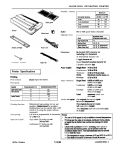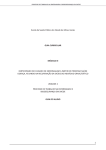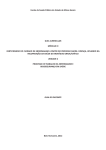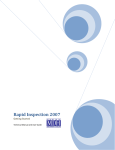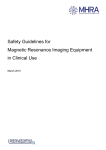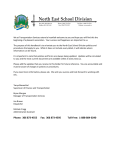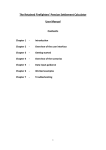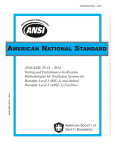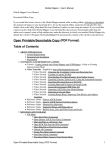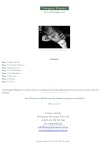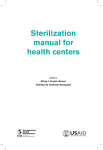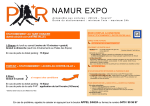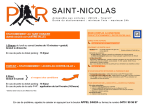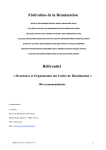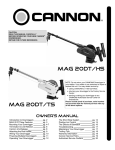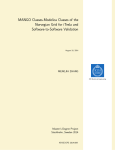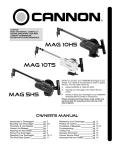Download airborne-inf-disease..
Transcript
Airborne Infectious Disease Management Methods for Temporary Negative Pressure Isolation Minnesota Department of Health Office of Emergency Preparedness Healthcare Systems Preparedness Program Airborne Infectious Disease Management Methods for Temporary Negative Pressure Isolation This guide has been produced by: Office of Emergency Preparedness Healthcare Systems Preparedness Program Acknowledgements This user guide has been written by The authors gratefully acknowledge the the Minnesota Department of Health Minnesota Emergency Readiness in conjunction with the University of Education and Training (MERET) at the Minnesota to assist hospital personnel University of Minnesota Centers for in the management of airborne Public Health Education and Outreach infection isolation. and the following individuals for their participation, assistance, and support Airborne Infectious Disease Management Methods for Temporary Negative Pressure Isolation AUTHORS: of this project: Jeanne Anderson Infection Control Practitioner Office of Emergency Preparedness Minnesota Department of Health Keith Carlson Director of Facilities Management Mercy Hospital and Health Care Center Moose Lake, MN Andrew Geeslin Engineering/Infection Control Intern University of Minnesota Gary Davis Plant Engineer LakeWood Health Center Baudette, MN Andrew Streifel Hospital Environmental Health Specialist Environmental Health and Safety University of Minnesota Pete Swanson Facility Services Manager Pipestone County Medical Center Pipestone, MN For further Information, please contact: Office of Emergency Preparedness Minnesota Department of Health 625 Robert Street North P.O. Box 64975 St. Paul, MN 55164-0975 The following individuals are gratefully Minnesota Department of Health acknowledged for their invaluable does not endorse particular brands among suggestions: competing products. Examples shown in these materials are for illustration only. Phone: (651) 201-5701 Fax: (651) 201-5720 All material in this document is in the public domain and may be used and reprinted This user guide is available on the Minnesota Department of Health Web site: http://www.health.state.mn.us/oep/training/ bhpp/isolation.html without special permission. Judene Bartley Vice President Epidemiology Consulting Services Inc. Beverly Hills, MI Rick Hermans Senior Project Manager Center for Energy and Environment Minneapolis, MN Curtain TNPI photographs courtesy of Ken Meade, Research Mechanical Engineer, NIOSH/CDC, USPHS MERET photos provided by Paul Bernhardt AIRBORNE INFECTIOUS DISEASE MANAGEMENT • PREPARED BY THE MINNESOTA DEPARTMENT OF HEALTH References Appendix Surge capacity Portable anteroom TNPI Temporary Negative Pressure Isolation Environmental controls Principles of airborne infectious disease management 37 20 16 13 5 3 2 Hospital preparedness for Introduction bioterrorism and other public health emergencies such as emerging airborne infectious diseases requires strategic planning to ensure that all components of respiratory protection programs, including environmental controls, are in place for airborne infection isolation rooms (AIIRs). Hospitals have insufficient facilities to provide airborne infection isolation for large numbers of patients with airborne infectious diseases presenting in a short time period.1, 2 However, AIIRs have been increased recently, due to requirements of National Bioterrorism Hospital Preparedness Program.3 Introduction 1 to other patients and health care workers.4 Heating, ventilation, and air conditioning (HVAC) expertise is essential for proper environmental management when planning control of airborne infectious disease outbreaks (natural or intentional). Design manuals and guidelines provide direction for infectious disease management.5-11 Refer to Appendix A, “2006 AIA Criteria” on page 21. Without adequate environmental controls, patients with airborne infectious diseases will pose a risk This guide will assist health care facility plant maintenance and engineering staff, in coordination with infection control professionals, to prepare for a natural or terroristic event, involving an infectious agent transmitted by airborne droplet nuclei. Examples of such agents include measles, varicella, and tuberculosis.5 Audience for this Guide Purpose of this Guide Goal of this Guide The intended audience for this guideline includes health care: Provide guidance on environmental A timely response is crucial for identification and containment of potentially infectious patients. The goal is for facilities to develop a 12-hour response to implement containment measures. Temporary negative pressure isolation methods are a safe alternative for hospitals that lack engineered AIIRs. These can be utilized in facilities to meet increased surge capacity for patient isolation. TNPI should also be used during hospital construction projects to reduce risks associated with airborne infectious diseases. facility engineering and maintenance infection control environmental health and safety management personnel controls for airborne infectious disease management Provide a general guide for temporary setup, installation, and operation of portable HEPA machines when used to create negative pressure in a hospital room/area Provide instruction on the use of: Pressure gauges Particle counters Outline of preventative maintenance schedule for HVAC equipment related to AIIR These temporary measures should be incorporated into the facility’s infection control and emergency response plans. AIRBORNE INFECTIOUS DISEASE MANAGEMENT References Appendix Surge capacity Portable anteroom TNPI Temporary Negative Pressure Isolation Environmental controls 37 20 16 13 5 3 • PREPARED BY THE MINNESOTA DEPARTMENT OF HEALTH Principles of airborne infectious disease management Introduction 2 1 Airborne infection isolation is based on the following hierarchy of control measures. Principles of airborne infectious disease management Administrative (work practice) controls Environmental controls Personal protective equipment (PPE) These measures are intended to reduce the risk for exposure to airborne infectious disease agents by uninfected persons. AIIRs and hospital systems in general must be monitored to provide continual protective measures. Refer to Appendixes B and C, AIIR and HVAC System Maintenance Schedules, on pages 22 and 23. Administrative Environmental Personal (work practice) controls controls protective equipment (PPE) Managerial measures that reduce the risk for exposure to persons who might have an airborne infectious disease. Physical or mechanical measures Equipment worn by health care Work practice controls include using infection control precautions while performing aerosol-generating procedures, closing doors to AIIRs, hand hygiene, and signage. EXAMPLES written policies and protocols to ensure the rapid identification, isolation, diagnostic evaluation, and treatment of persons likely to have an airborne infectious disease (as opposed to administrative workers and others to reduce control measures) used to reduce exposure to communicable the risk for transmission of airborne diseases. infectious diseases. EXAMPLES ventilation EXAMPLES gowns filtration gloves ultraviolet germicidal irradiation masks AIIRs eye protection local exhaust ventilation devices respirators AIRBORNE INFECTIOUS DISEASE MANAGEMENT References Appendix Surge capacity Portable anteroom TNPI Temporary Negative Pressure Isolation 37 20 16 13 5 Environmental controls • PREPARED BY THE MINNESOTA DEPARTMENT OF HEALTH Principles of airborne infectious disease management Introduction 2 1 3 ••• A difference in pressure Environmental controls This user guide will focus on the environmental controls necessary for airborne infection isolation. The ventilation parameters essential for airborne infection isolation rooms/areas include: Pressure management for appropriate airflow direction; Room air changes for dilution ventilation; and Filtration to remove infectious particles. Pressure management L NEGATIVELY PRESSURIZED H POSITIVELY PRESSURIZED FIGURE 1 Illustrations used to identify Negatively (top) and Positively (bottom) pressurized air space. For the purposes of this guide, pressure refers to the differential pressure between two spaces (FIGURE 1). In health care settings, the two spaces are typically the isolation room and the corridor. For AIIR, the room should be negatively pressurized in relation to the corridor. This helps to prevent infectious particles from escaping the room envelope. If an anteroom is present between the AIIR and the corridor, the AIIR may be negatively or positively pressurized to the anteroom. However, if the AIIR is positively pressurized to the anteroom, the anteroom must be negatively pressurized to the corridor. causes movement of air from areas at higher pressure to those at lower pressure. The greater the pressure difference, the greater the resulting air velocity. The movement of air is used to help provide containment of infectious particles by providing clean to dirty airflow. Refer to Appendix D, “Using a Pressure Gauge to Measure Relative Pressurization Between Two Spaces” on page 24 for instructions on using a pressure gauge to determine differential pressure. ••• The differential pressure or pressure offset is established by mechanically adjusting the supply and exhaust air. For a negative pressure room, the sum of the mechanically exhausted air must exceed the sum of the mechanically supplied air. This offset forces air to enter the room under the door and through other leakages and prevents infectious particles from escaping.9 ••• In order to maintain consistent offset airflow, the difference between exhaust and supply should create a pressure differential of about 0.01 inch water gauge (in. w.g.) or 2.5 Pascals (Pa).9 Pressure in this application is used to induce airflow from adjacent spaces into the isolation room. AIRBORNE INFECTIOUS DISEASE MANAGEMENT References Appendix Surge capacity Portable anteroom TNPI Temporary Negative Pressure Isolation 37 20 16 13 5 Dilution ventilation Environmental controls Dilation ventilation Filtration Filtration Mechanical ventilation is used to exchange the air in a space. The time required for removing a given percentage of airborne particles from a room or space depends on the number of air changes per hour (ACH), location of the ventilation inlet and outlet, and the physical configuration of the room or space (FIGURE 2). Refer to Appendix E, “Using a HEPA Filter for Dilution Ventilation” on page 26. • PREPARED BY THE MINNESOTA DEPARTMENT OF HEALTH Principles of airborne infectious disease management Introduction 2 1 4 When used correctly, portable HEPA filters prove to be an effective method for achieving an airborne isolation environment.12 When properly installed and maintained, filters for clinical spaces should be able to remove at least 90% of particles (0.5 microns in size and larger) 9 from outside and inside air. For the purposes of this guide, filtration refers to the process of passing air through a filter. Hospital buildings have some of the highest filtration requirements. Without filtration, particle concentrations accumulate in indoor environments. This can cause toxic effects even in healthy people. For evaluation of hospital HVAC systems and HEPA filters refer to Appendix G, “Using a Particle Counter to Assess Indoor Air Quality and Filter Efficiency” on page 29. Filtration reduces the risk for transmitting airborne infectious agents. Depending upon their size, particles may be deposited in the upper respiratory tract or the lower respiratory tract of humans. Particles can also be deposited in open wounds during dressing changes or invasive procedures. See Appendix F, “Microorganisms Associated with Airborne Transmission” on page 28. For information on filter selection and performance, see Appendix H, “Data Interpretation” on page 34. See Appendix I, “Sample Log for Measuring Particle Counts” on page 36. FIGURE 2: ACH AND TIME REQUIRED FOR REMOVAL EFFICIENCIES 90% 99% 99.9% EFFICIENCY EFFICIENCY EFFICIENCY 2 69 138 207 4 35 69 104 6 23 46 69 8 17 35 52 10 14 28 41 12 12 23 35 15 9 18 28 20 7 14 21 50 3 6 8 ACH Modified from Table B.1, CDC Guidelines for Environmental Infection Control in Health-Care Facilities, 2003.5 M INUTES Time (minutes) required for removal of 90%, 99%, and 99.9% of airborne-contaminants. 210 200 190 180 170 160 150 140 130 120 110 100 90 80 70 60 50 40 30 20 10 90% EFFICIENCY 99% EFFICIENCY 99.9% EFFICIENCY 2 4 6 8 10 12 15 20 50 AIR CHANGES PER HOUR (ACH) Perfect mixing of air is assumed. For rooms with stagnant air spaces, the time required may be much longer than shown. This is intended only as an approximation and is for ideal ventilation configurations. AIRBORNE INFECTIOUS DISEASE MANAGEMENT References Appendix Surge capacity Portable anteroom 37 20 16 13 TNPI Temporary Negative Pressure Isolation PREPARED BY THE MINNESOTA DEPARTMENT OF HEALTH Environmental controls Principles of airborne infectious disease management Introduction 3 2 1 TNPI Installations Must Observe Building & Fire Codes All of the TNPI installations must observe state building and fire codes, and National Fire Protection Association (NFPA) 101 (Life Safety Code). Being able to set up a TNPI requires planning and early contact with the authority that has jurisdiction (your State Health Department) to establish and verify compliance with applicable codes. In Minnesota, you can contact Fernando Nacionales, P.E., Engineering Services Section at (651) 201-3712 or [email protected]. There are three types of temporary isolation. The two most effective methods of achieving temporary isolation are: H 1 2 Discharging air to the outside H+ Discharging air to return air system infection isolation is needed and there are no available or insufficient AIIRs, such as can happen when there is an outbreak of an airborne infectious disease with large numbers of communicable patients. Temporary isolation is designed to protect patients and staff from contracting or transmitting highly infectious diseases. HEPA Filter Maintenance If the HEPA filter is in place for an extended period of time, the pre-filter should be changed when lint buildup becomes visible (FIGURE 3). It is important to completely follow the manufacturer’s directions for operation and maintenance of portable HEPA filter machines. One less effective methods of achieving temporary isolation is: H 5 TNPI is considered when airborne Temporary Negative Pressure Isolation TNPI Portable HEPA filters have been used in the past to isolate patients. These filters can also be used as an air scrubber. When used in this fashion, the filter simply cleans the air. It does not provide pressure management for appropriate airflow direction. The filter is placed in the room and turned on, without attached ductwork. This is known as room recirculation and is not a preferred method for isolation. • 3 Curtain TNPI FIGURE 3 Pre-filter at inlet side of HEPA machine (is shown). AIRBORNE INFECTIOUS DISEASE MANAGEMENT References Appendix Surge capacity Portable anteroom 37 20 16 13 TNPI Temporary Negative Pressure Isolation • PREPARED BY THE MINNESOTA DEPARTMENT OF HEALTH Environmental controls Principles of airborne infectious disease management Introduction 3 2 1 6 Discharging air to the outside 1 Discharging air to the outside H 1 Steps for + discharging air to the outside This option is one of the two preferred methods for achieving TNPI. In this method, a HEPA filter is used to exhaust room air outside through the window. (Clearly, a window is required for this method.) (FIGURE 4) 1. Select a room L 2. Set up pre-constructed window adapter NEGATIVELY PRESSURIZED • The two main purposes of the HEPA machine in this application are to clean contaminated air and induce negative pressure in the room. 3. Set up HEPA machine and flex duct Creates negative pressure room (airflow into patient room from the corridor or anteroom) 4. Seal return air grille 5. Turn on HEPA machine and adjust flow • Because the discharged air is HEPA filtered, no extra consideration for air discharge location is required. To prevent pulling air from return air system, the exhaust/return grilles should be sealed with tape. EXHAUST/RETURN SUPPLY Set up HEPA machine and flex duct. tip CLEANED AIR HEPA MACHINE Becoming familiar with operating the negative pressure HEPA filter machine FIGURE 4 HEPA fan exhausting clean air outside through the window. on a regular basis (e.g., during construction projects), will better prepare the user for an emergency response. AIRBORNE INFECTIOUS DISEASE MANAGEMENT References Appendix Surge capacity Portable anteroom 37 20 16 13 TNPI Temporary Negative Pressure Isolation • PREPARED BY THE MINNESOTA DEPARTMENT OF HEALTH Environmental controls Principles of airborne infectious disease management Introduction 3 2 1 7 Select a room You should choose a room to set up TNPI. The HEPA machine should be set up in advance to placing the patient with a suspected airborne infectious disease in the room. STEP If possible, select a room without transfer grilles. If no such room exists, completely seal the grilles to promote negative pressure. 2 Set up pre-constructed window adapter 3 Set up HEPA machine and flex duct Connect the flex duct to window adapter and HEPA machine. (FIGURE 6) 4 Seal return air grille To prevent pulling air from return air system, the return grilles should be sealed with tape. A sheet of plastic or cardboard can be used provided that the edges are completely sealed with tape. 5 Turn on HEPA machine and adjust flow Once the flex duct is connected to the window template and the HEPA machine, the machine should be turned on. (FIGURE 7) Adjust the flow on the output until the desired pressure differential of negative 2.5 Pa (pressure in corridor is greater than pressure in patient room) is reached. Increasing the flow will increase the pressure differential, and decreasing the flow will decrease the pressure differential. The pressure differential should be measured with a hand-held digital pressure gauge. The pressure should be monitored daily. When using this option to establish TNPI, a window adapter must be constructed. This is used to provide a connection to the flex duct. (FIGURE 5) The template should be constructed out of wood to fit into a standard window in your hospital’s patient care rooms and should provide an airtight fit. A piece of sheet metal (a flange) of the same diameter as the flex duct should be fixed to the circular hole in the wood to serve as an adapter between the wood template and the flex duct. The use of a window template, flex duct, and fan is common in hospital construction. STEP STEP 1 STEP STEP Discharging air to the outside Additional Notes for Discharging Air to the Outside FIGURE 6 Flex duct connected to window template. The other end of the flex duct should be connected to the HEPA machine. • In locations with seasonal cold (below-freezing) weather, it may be necessary to install a damper or louver on the outside of the window template. This will help to prevent airflow restriction due to condensation or ice/snow buildup. • When no longer needed, the HEPA filter and flex duct should be wiped down with a hospital-approved disinfectant. FIGURE 5 Window adapter with flex duct attached. FIGURE 7 The flow rate on this machine is adjusted with the dial on the right-hand side. • HEPA filters can also be used to enhance dilution ventilation. Refer to Appendix E, “Using a HEPA Filter for Dilution Ventilation” on page 26 for a discussion and example of dilution ventilation. AIRBORNE AIRBORNE INFECTIOUS INFECTIOUS DISEASE DISEASE MANAGEMENT MANAGEMENT References Appendix Surge capacity Portable anteroom 37 20 16 13 TNPI Temporary Negative Pressure Isolation • • PREPARED PREPARED BY BY THE THE MINNESOTA MINNESOTA DEPARTMENT DEPARTMENT OF OF HEALTH HEALTH Environmental controls Principles of airborne infectious disease management Introduction 3 2 1 8 Discharging air to return air system 2 Discharging air to return air system H 2 Steps for discharging air to return air system 1. Select a room L 2. Attach flex duct adapter to desired return grille NEGATIVELY PRESSURIZED 3. Set up HEPA filter machine and flex duct Creates negative pressure room (airflow into patient room from the corridor or anteroom) 4. Seal remaining return air grilles 5. Turn on HEPA filter machine and adjust flow This option is one of the two preferred methods for achieving TNPI. In this method, a HEPA filter machine is used to discharge room air into the return air system. (FIGURE 8) • You must be careful when exhausting additional large volumes of air through the return air system. • Because the air is HEPA filtered, it is okay to exhaust it through the return air system. If air was being exhausted by a regular (non-HEPA filtered) large fan, it should not be discharged through the return air system. Care must be taken EXHAUST/RETURN tip when exhausting SUPPLY a large volume of air into the return air system, as it can over-pressurize the duct. Such changes can disturb the air-balancing HEPA MACHINE of rooms on the same return/exhaust air system. FIGURE 8 Discharging air to return air system Attach flex duct adapter to desired return grille. AIRBORNE AIRBORNE INFECTIOUS INFECTIOUS DISEASE DISEASE MANAGEMENT MANAGEMENT References Appendix Surge capacity Portable anteroom 37 20 16 13 TNPI Temporary Negative Pressure Isolation • • PREPARED PREPARED BY BY THE THE MINNESOTA MINNESOTA DEPARTMENT DEPARTMENT OF OF HEALTH HEALTH Environmental controls Principles of airborne infectious disease management Introduction 3 2 1 9 Select a room You should choose a room to set up TNPI. The HEPA machine should be set up in advance to placing the patient with a suspected airborne infectious disease in the room. STEP If possible, select a room without transfer grilles. If no such room exists, completely seal the grilles to promote negative pressure. 2 Attach flex duct adapter to desired return grille Next, attach flex duct adapter to desired return grille. Ideally, if the return is low, connect the flex duct here. However, most returns are high on the wall or ceiling and these can be connected in the same way. It is important to provide a tight seal between the flex duct and the adapter as well as between the adapter and the return grille. (FIGURE 9) 4 Seal remaining air grilles To prevent pulling air from return air system, additional exhaust/return grilles should be sealed with tape. (FIGURE 11) Most rooms have only one supply, a return grille, and one bathroom exhaust. 100% of bathroom discharge is exhausted outside, so no extra consideration is required. If there is more than one return grille, which is uncommon, the additional grille(s) should be sealed. A sheet of plastic or cardboard can be used provided that the edges are completely sealed with tape. FIGURE 9 A return grille adapter. STEP Set up HEPA machine and flex duct Connect the flex duct to return grille adapter and HEPA machine. (FIGURE 10) 5 Turn HEPA machine on and adjust flow Once the flex duct is connected to the window template and the HEPA machine, the machine should be turned on. Adjust the flow on the output until the desired pressure differential of negative 2.5 Pa (pressure in corridor is greater than pressure in patient room) is reached. Increasing the flow will increase the pressure differential, and decreasing the flow will decrease the pressure differential. The pressure differential should be measured with a hand-held digital pressure gauge. The pressure should be monitored daily. Additional Notes for Discharging Air to Return Air System • You must be careful when exhausting additional large volumes of air through the return air system. Generally, it is easy to differentiate between a supply grille and return grille. If you are not sure, you can use a smoke stick to check airflow direction. 3 STEP 1 STEP STEP Discharging air to return air system • When no longer needed, the HEPA filter and flex duct should be wiped down with a hospital-approved disinfectant. FIGURE 10 A return grille adapter with flex duct attached. FIGURE 11 This return duct must be sealed to prevent pulling air from return air system. • HEPA filters can also be used to enhance dilution ventilation. Refer to Appendix E, “Using a HEPA Filter for Dilution Ventilation” on page 26 for a discussion and example of dilution ventilation. AIRBORNE INFECTIOUS DISEASE MANAGEMENT References Appendix Surge capacity Portable anteroom 37 20 16 13 TNPI Temporary Negative Pressure Isolation • PREPARED BY THE MINNESOTA DEPARTMENT OF HEALTH Environmental controls Principles of airborne infectious disease management Introduction 3 2 1 10 Curtain TNPI 3 The TNPI methods 1. Discharging Air Curtain TNPI to the Outside, and 2. Discharging Air to Return Air System are preferred over 3. Curtain TNPI. TNPI Installations Must Observe Building & Fire Codes ADJACENT SPACE INFECTIOUS DISEASE ZONE Curtain TNPI does not provide negative pressure for the entire room, but induces airflow into the enclosed space from surrounding areas and discharges HEPA filtered air from the enclosure to the surrounding space. In this method, a HEPA filter is used to provide a type of relative negative pressure around a patient. (FIGURE 12) • This method should be used for non-ambulatory patients. • The area around the bed can be “sealed off” by attaching fire-rated plastic sheeting to the curtain track along with duct tape to attach the plastic to the floor. As stated earlier, Temporary Negative Pressure Isolation (TNPI) is considered when airborne infection isolation is needed and there is no available or insufficient AIIRs. This could happen when the number of infectious patients exceeds the number of available rooms. FIGURE 12 Curtain TNPI observe state building and fire codes, and PLASTIC CURTAIN HEAD WALL All of the TNPI installations must National Fire Protection Association (NFPA) 101 (Life Safety The area around the bed can be “sealed off” by attaching fire-rated plastic sheeting. Code). Being able to set up a TNPI requires planning and early contact with the authority that has jurisdiction (your State Health Department) to establish and verify compliance with The intake must be within the plastic enclosure and the output must be outside the plastic enclosure. applicable codes. In Minnesota, you can contact: Fernando Nacionales, P.E. Engineering Services Section at (651) 201-3712 or [email protected]. AIRBORNE INFECTIOUS DISEASE MANAGEMENT References Appendix Surge capacity Portable anteroom 37 20 16 13 TNPI Temporary Negative Pressure Isolation • PREPARED BY THE MINNESOTA DEPARTMENT OF HEALTH Environmental controls Principles of airborne infectious disease management Introduction 3 2 1 11 3 1. Select a room 2. Attach fire-rated plastic to ceiling 3. Set up portable HEPA filter machine 4. Attach remaining surfaces with strong tape 5. Turn on portable HEPA filter 1 Select a room If the patient is already in a hospital room, the room can be adapted for the Curtain TNPI method. Due to the proximity of the machine to the patient, noise considerations and patient comfort must be addressed. (FIGURE 13) As with the health care workers caring for the patient, the health care workers setting up Curtain TNPI must also wear PPE. STEP H Steps for setting up Curtain TNPI STEP Curtain TNPI 2 Attach fire-rated plastic to ceiling It is important to note that the plastic must be able to fit nearly all the way around the bed. (FIGURE 14) Also, the height should be at least six inches taller than the ceiling, which allows for the plastic to be taped to the floor. For accessibility to the patient, the plastic should be at least three feet from the bed on all sides. Most patient care rooms have curtain tracks installed around the bed on the ceiling. These can be adapted for use with the plastic sheeting. In addition, clips can be purchased that will allow the plastic sheeting to be attached to the ceiling grid (assuming the room has a suspended ceiling). (FIGURE 15) FIGURE 13 Standard patient room. FIGURE 15 Plastic can be attached to ceiling tile grid or curtain track with clips. FIGURE 14 Health care workers setting up Curtain TNPI must wear PPE. AIRBORNE INFECTIOUS DISEASE MANAGEMENT References Appendix Surge capacity Portable anteroom 37 20 16 13 TNPI Temporary Negative Pressure Isolation • PREPARED BY THE MINNESOTA DEPARTMENT OF HEALTH Environmental controls Principles of airborne infectious disease management Introduction 3 2 1 12 The HEPA filter should be inserted into the plastic sheeting. (FIGURE 16) The plastic needs to be cut so that the HEPA filter can be fit into the space. The intake must be within the plastic enclosure and the output must be outside the plastic enclosure. This will draw the air from the enclosure, filter it, and exhaust it to the rest of the room. This will provide an airflow that will help to isolate the patient. 4 Attach remaining surfaces with strong tape Once the HEPA filter is installed and sealed with tape, the remaining surfaces need to be sealed with tape. (FIGURE 17) The hanging plastic curtain should be taped to the floor. This will help to minimize the “leakage area” of the enclosure and provide stronger airflow and containment. The curtain near the HEPA filter must be taped to the head wall. This will also help to minimize the leakage area of the enclosure. STEP 3 Set up portable HEPA filter machine STEP STEP Curtain TNPI 5 Turn on portable HEPA filter The last step is to turn on the HEPA filter. If set up correctly, the sides of the plastic will pull in (as if under a vacuum). This will indicate that the enclosure is under negative pressure. Additional Notes for Curtain TNPI • This method is not the preferred method for isolating a patient. Health care workers will not be able to move the patient to another area in the building without completely disassembling the Curtain TNPI setup. In addition, the set up process can be time consuming and the majority of the set up takes place while the patient is within the enclosure which could increase transmission risk. FIGURE 16 Portable HEPA filter machine installed in plastic sheeting. The plastic should be taped around the HEPA machine to provide a seal. Andy G, take a picture FIGURE 17 Plastic curtain taped to wall. FIGURE 2 Portable HEPA filter machine installed in plastic sheeting. The plastic should be taped around the HEPA machine to provide a seal. • When no longer needed, the plastic curtain and HEPA filter should be wiped down with a hospital-approved disinfectant. • HEPA filters can also be used to enhance dilution ventilation. Refer to Appendix E, “Using a HEPA Filter for Dilution Ventilation” on page 26 for a discussion and example of dilution ventilation. AIRBORNE INFECTIOUS DISEASE MANAGEMENT References Appendix Appendix Surge capacity Surge Portable Capacity anteroom Portable TNPI Anteroom Negative Temporary Pressure Isolation TNPI Environmental Temporary Negative controls Pressure Isolation 37 20 10 16 10 510 310 Portable anterooms can be purchased with portable filters to create a space at the entrance to a standard room for TNPI. Portable anteroom (FIGURE 18) • PREPARED BY THE MINNESOTA DEPARTMENT OF HEALTH Principles of airborne airborne disease infectious infectious disease management management 10 2 Introduction Introduction 1 Steps for using a Portable Anteroom 1. Set up anteroom to manufacturer’s recommendations The advantage of a portable anteroom is the relatively easy conversion of regular rooms to AIIRs without manipulation of the existing room ventilation. Portable anterooms are easy to set up and convenient to use because any chosen room can be converted quickly. 2. Attach the HEPA machine A disadvantage of a portable anteroom is the inability to move beds through the door. Another disadvantage is that they do not depressurize the room unless the room door is open. 5. Both doors should never be open at the same time PORTABLE ANTEROOM 3. Open the doors while HEPA machine is on 4. Close the doors after the patient and/or caregiver enters or leaves the room 6. Clean and disinfect the portable anteroom cover tip Before you purchase BATHROOM an anteroom, be sure the anteroom and HEPA filter are compatible and that HEPA FIGURE 18 Portable Anteroom the anteroom is compatible with the Attach the portable HEPA filter to the appropriate sized portal on the side of the portable anteroom. When turned on, the HEPA machine should cause the sides of the portable anteroom to pull inward. The anteroom should be placed in front of the patient room door and taped to the wall to secure and cover the seams. 2 13 door frame. AIRBORNE INFECTIOUS DISEASE MANAGEMENT Appendix Surge capacity 37 20 16 STEP References 1 Portable anteroom • PREPARED BY THE MINNESOTA DEPARTMENT OF HEALTH TNPI Temporary Negative Pressure Isolation Environmental controls Principles of airborne infectious disease management Introduction 5 3 2 1 Set up anteroom STEP The anteroom should be set up according to manufacturer’s recommendations. The anteroom should be placed in front of the patient room door and taped to the wall to secure and cover the seams. 2 Attach the HEPA machine 3 Open the doors The door to the patient room and portable anteroom are opened for patient transport while the HEPA machine is on. STEP STEP Attach the portable HEPA filter to the appropriate sized portal on the side of the portable anteroom. When turned on, the HEPA machine should cause the sides of the portable anteroom to pull inward, indicating suction. 4 Close the doors After the patient and/or caregiver enters or leaves the room, the room door and portable anteroom door should be closed. 14 AIRBORNE INFECTIOUS DISEASE MANAGEMENT Appendix ˚x Surge capacity Surge Portable Capacity anteroom Portable TNPI Anteroom Negative Temporary Pressure Isolation TNPI Environmental Temporary Negative controls Pressure Isolation 37 20 10 16 10 510 310 STEP References 5 • PREPARED BY THE MINNESOTA DEPARTMENT OF HEALTH Principles Principles of of airborne airborne infectious disease infectious disease management management 10 2 Introduction Introduction 1 Both doors not open at same time STEP If individual health care workers or visitors enter the room, one door should be closed before the other is opened. Both doors should never be open at the same time. This prevents short circuiting of air through an open doorway. 6 Clean portable anteroom cover When no longer needed, the portable anteroom cover should be cleaned and disinfected with a hospital-approved disinfectant. Additional Notes for Portable Anterooms • The door on the portable anteroom and patient room should be closed except for entry and egress. In addition, only one door should be opened at one time. • There are no standards on the magnitude of anteroom pressure. Therefore, there is no suggestion on airflow output or pressure differential for portable anterooms. It is only suggested that the airflow is strong enough to pull in the sides of the anteroom while not so strong that it produces excess noise. tip Some permanently engineered AIIRs are designed with anterooms. 2 15 AIRBORNE INFECTIOUS DISEASE MANAGEMENT References Appendix 37 20 Surge capacity PREPARED BY THE MINNESOTA DEPARTMENT OF HEALTH Portable anteroom TNPI Temporary Negative Pressure Isolation Environmental controls Principles of airborne infectious disease management Introduction 13 5 3 2 1 Isolation surge capacity is the Surge capacity • ability to manage high volumes of specialized patients. Under extraordinary circumstances where the quantity of engineered airborne infection isolation rooms is insufficient to meet surge demand for patient isolation, hospitals can take various measures to protect patients and staff.13 This section describes different methods of isolating large numbers of patients, including: Smoke Zones Engineered System 16 The Goal of Isolation Surge Capacity Housing large numbers of patients with airborne infectious diseases is challenging. The goal of surge capacity is to provide areas with safeguards to protect you and other patients from exposure to airborne infectious agents. (FIGURE 19) An infectious disease zone (IDZ) is a space used to isolate large numbers of patients. Temporary Surge Area Safe Areas NON-IDZ SAFE AREA PATIENT CARE ROOMS NURSES STATION SAFE AREA SUPPLY/UTILITY IDZ PATIENT CARE ROOMS FIGURE 19 An infectious disease zone (IDZ) is a space used to isolate large numbers of patients. A temporary constructed anteroom (safe area) for surge area is shown. A safe area or anteroom (FIGURE 19) should be created between the IDZ and the rest of the hospital. A portable HEPA filter is used to pressurize the anteroom. This also provides clean air in the anteroom. Different models of HEPA filters have different configurations of the air intake. Regardless of the model, the air intake should be drawing air into the HEPA filter from the IDZ. The filtered exhaust should be discharged into the anteroom. An airtight seal should be made for all connections. The anteroom should be large enough to accommodate function (for example, change clothes, hang PPE, dispose of waste, etc.). AIRBORNE INFECTIOUS DISEASE MANAGEMENT References Appendix 37 20 Surge capacity • PREPARED BY THE MINNESOTA DEPARTMENT OF HEALTH Portable anteroom TNPI Temporary Negative Pressure Isolation Environmental controls Principles of airborne infectious disease management Introduction 13 5 3 2 1 17 Smoke Zones Smoke Zones Hospitals have smoke zones that are designed to evacuate the smoke if a fire occurs. The zone has smoke-stopped barriers to prevent smoke movement between zones. These airtight barriers would allow for potential isolation of several hospital beds. The patient rooms themselves may not be capable of being depressurized by the existing ventilation system. The smoke zone, however, is designed with fire rated doors that close as well as entire zone exhaust capability. Zone exhaust capability effectively isolates the wing, suite or space from other areas of the health care facility. These zones are routinely tested for fire management. Smoke Zones as Perimeter of IDZ The smoke zones can be used as the perimeter of an infectious disease zone (IDZ). (FIGURE 20) This area can also be negatively pressurized in a method similar to TNPI #1 and #2. That is, air can be discharged through the window, into the return air system, or discharged to an adjacent space using a portable HEPA filter machine. As always, when discharging to the return air system, users must be cautious with the volume of air being discharged. CORRIDOR WALL 2 HOUR FIRE WALL SMOKE BARRIER FIGURE 20 Example of the hospital smoke zones that could be considered for potential isolation areas. AIRBORNE INFECTIOUS DISEASE MANAGEMENT References Appendix 37 20 Surge capacity • PREPARED BY THE MINNESOTA DEPARTMENT OF HEALTH Portable anteroom TNPI Temporary Negative Pressure Isolation Environmental controls Principles of airborne infectious disease management Introduction 13 5 3 2 1 18 Engineered System Engineered System Ducted to the Outside If the suite or wing is exclusively served by a single air handling unit, the facility engineer may be able to provide 100% exhaust from the area. (FIGURE 21) In this method, the infectious disease zone (IDZ) is depressurized using an exhaust diversion system taking air from the IDZ and exhausting it to the outside 25 feet away from public access and air intakes. Damper Manipulation and Changes to the Ventilation System This method will require damper manipulation and changes to the ventilation system that must be preformed by the facility’s management. The exact steps required will vary from hospital to hospital. For example, some hospitals will need to change the settings on their Building Automation System (BAS). Others may be designed with pre-existing controls in the area that allow for this scenario. PPE should be worn inside the IDZ. The doors to the IDZ must be kept closed except when entering or exiting. FIGURE 21 Engineered System AIRBORNE INFECTIOUS DISEASE MANAGEMENT References Appendix 37 20 Surge capacity • PREPARED BY THE MINNESOTA DEPARTMENT OF HEALTH Portable anteroom TNPI Temporary Negative Pressure Isolation Environmental controls Principles of airborne infectious disease management Introduction 13 5 3 2 1 19 Temporary Surge Area Temporary Surge Area Discharging through a window Using HEPA Filter Some considerations to keep in mind when discharging air through a window are: This method can be used to create a temporary surge area using a HEPA filter. • A window template can be created to exhaust a suite of rooms through a flexible duct hookup from the HEPA filter to the window. The three options for creating a temporary surge area using a HEPA filter are listed below. (FIGURE 22) They are similar to Types #1 and #2 of TNPI for a patient room. Each of these options should be used in conjunction with a safe area (anteroom). • Large exhaust fans placed in the window can be used instead of HEPA filters if the air is exhausted 25 feet away from public access and air intakes. • More than one machine may be needed to establish appropriate pressure differential. Discharging through a window Discharging to an adjacent space Discharging to an adjacent space Some considerations to keep in mind when discharging air to an adjacent space are: Discharging to a return air system • The air must be HEPA filtered. These three options may be used in combination to achieve desired pressure differential. Discharging to a return air system Some considerations to keep in mind when discharging air to a return air system are: • The air must be HEPA filtered. • The air in the IDZ can be discharged to an adjacent area outside the IDZ, within the building. BUILDING EXTERIOR WINDOW TEMPLATE RETURN AIR GRILLE HEPA MACHINE • A return air grille adapter is used to connect a flex duct (from the HEPA filter) to the return air grille. • As always, when discharging to the return air system, users must be cautious with the volume of air being discharged. HEPA MACHINE HEPA MACHINE ADJACENT SPACE FIGURE 22 Engineered System (shown with three different options). AIRBORNE INFECTIOUS DISEASE MANAGEMENT References Appendix 37 Appendix • PREPARED BY THE MINNESOTA DEPARTMENT OF HEALTH Surge capacity Portable anteroom TNPI Temporary Negative Pressure Isolation Environmental controls Principles of airborne infectious disease management Introduction 16 13 5 3 2 1 20 A: 2006 AIA Criteria 21 B: AIIR Maintenance Schedule 22 C: HVAC System Maintenance Schedule 23 D: Using a Pressure Gauge to Measure Relative Pressurization Between Two Spaces 24 Using a Pressure Gauge 25 E: Using a HEPA Filter for Dilution Ventilation 26 F: Microorganisms Associated with Airborne Transmission 28 G: Using a Particle Counter to Assess Indoor Air Quality and Filter Efficiency 29 Portable HEPA Filters 30 Testing Efficiency of Building Filtration System 31 Building Filtration System: Inside / Outside the Building 32 Building Filtration System: Before / After the Filter 33 H: Data Interpretation 34 I: Sample Log for Measuring Particle Counts 36 AIRBORNE INFECTIOUS DISEASE MANAGEMENT References Appendix 37 • PREPARED BY THE MINNESOTA DEPARTMENT OF HEALTH Surge capacity Portable anteroom TNPI Temporary Negative Pressure Isolation Environmental controls Principles of airborne infectious disease management Introduction 16 13 5 3 2 1 21 A 2006 AIA Criteria APPENDIX A 2006 American Institute of Architects (AIA) Guidelines for Design and Construction of Hospital and Health Care Facilities The following AIIR criteria are specified in the 2006 American Institute of • If alarms are installed, allowances shall be made to prevent nuisance alarms Architects (AIA) Guidelines for Design of monitoring devices. (AIA: Table 2.1-2) and Construction of Hospital and Health Care Facilities .9 Hospital AIIRs are required to meet Differential pressure shall be a minimum of 0.01-in. w.g. (2.5 Pascals). • Provide ventilation to ensure ≥ 12 air changes/hour (ACH). (AIA: Table 2.1-2) • Rooms with reversible airflow provisions for the purpose of switching criteria that was in place at the time between protective environment and AIIR functions are not acceptable. of construction for new construction (AIA: Table 10.2.2.1 (3)) and major renovation. However, upgrading AIIRs to meet the criteria • Airborne infection isolation room perimeter walls, ceilings, and floors, including in the 2006 guidelines will better penetrations, shall be sealed tightly so that air does not infiltrate the prepare hospitals to isolate patients environment from the outside or from other spaces. (AIA 3.2.2.4 (2a)) with airborne infectious diseases. These criteria are consistent with • Airborne infection isolation room(s) shall have self-closing devices on all room exit doors. (AIA: 3.2.2.4 (2b)) CDC Guidelines for Preventing the Transmission of Mycobacterium tuberculosis in Health-Care • Rooms shall have a permanently installed visual mechanism to constantly monitor the pressure status of the room when occupied by patients Settings, 2005. with an airborne infectious disease. The mechanism shall continuously monitor the direction of the airflow. (AIA: 3.2.2.4 (4)) • All areas for inpatient care, treatment and diagnosis, and those areas providing direct service or clean supplies such as sterile and clean processing, etc., shall have filter efficiency of 90% based on average dust spot efficiency per American Society of Heating, Refrigeration and Air-conditioning Engineers (ASHRAE) 52.1-1992. (AIA: Table 2.1-3) AIRBORNE INFECTIOUS DISEASE MANAGEMENT TITLE OF THE MANUAL GOES HERE Appendix References 37 •• PREPARED BY BY THE THE MINNESOTA MINNESOTA DEPARTMENT DEPARTMENT OF OF HEALTH HEALTH PREPARED Surge capacity Portable anteroom TNPI Temporary Negative Pressure Isolation Environmental controls Principles of airborne infectious disease management Introduction 16 13 5 3 2 1 22 B AIIR Maintenance Schedule APPENDIX B Sample Preventive Maintenance Schedule for AIIRs For each item, place a “X” in the appropriate box. “Y” indicates “Yes. Room is in compliance.” “N” indicates “No. Room does not comply.” “NA” indicates “Not Applicable to this room.” DATE ROOM WINDOWS DOORS ALARMS MECHANICAL CLOSED/SEALED SELF-CLOSING OPERATIONAL ELECTRONICS FUNCTIONING DEVICE ZEROS WHEN DOOR OPENS Y Y Y Y Y Y Y Y Y Y Y Y Y Y Y Y Y Y Y Y N N N N N N N N N N N N N N N N N N N N Y N NA Y N NA Y N NA Y N NA Y N NA Y N NA Y N NA Y N NA Y N NA Y N NA Y N NA Y N NA Y N NA Y N NA Y N NA Y N NA Y N NA Y N NA Y N NA Y N NA Y N NA Y N NA Y N NA Y N NA Y N NA Y N NA Y N NA Y N NA Y N NA Y N NA Y N NA Y N NA Y N NA Y N NA Y N NA Y N NA Y N NA Y N NA Y N NA Y N NA Y N NA Y N NA Y N NA Y N NA Y N NA Y N NA Y N NA Y N NA Y N NA Y N NA Y N NA Y N NA Y N NA Y N NA Y N NA Y N NA Y N NA Y N NA Y N NA Y N NA * Pressure should be checked daily when occupied, or monthly when unoccupied. PRESSURE READING* HAND-HELD ELECTRONIC COMMENTS AIRBORNE INFECTIOUS DISEASE MANAGEMENT References Appendix 37 • PREPARED BY THE MINNESOTA DEPARTMENT OF HEALTH Surge capacity Portable anteroom TNPI Temporary Negative Pressure Isolation Environmental controls Principles of airborne infectious disease management Introduction 16 13 5 3 2 1 23 C HVAC System Maintenance Schedule APPENDIX C Sample Preventive Maintenance Schedule for HVAC Systems For each item, place a “X” in the appropriate box. “Y” indicates “Yes. Fan is in compliance.” “N” indicates “No. Fan does not comply.” FAN ID/LOCATION:________________________________________________________________ INSPECTION DATE:________________________________________________________________ TASK Inspect and clean exhaust grilles to prevent blockage & airflow retardation Visually inspect filter housing for holes and proper filter seal Clear outside air intake of debris Check return/exhaust dampers move freely Check filters for proper installation/spacers Check pressure set points Check steam/CW lines have no leaks Check return/exhaust belts are tight Check fan bearings/sheaves are lubricated Check humidifier controls are in working order Check fan lights are in working order/PSI Check fan cleanliness YES NO Y N FOLLOW UP DATE DATE Y N Y N Y N Y N Y N Y N Y N Y N Y N Y N Y N DATE DATE DATE DATE DATE DATE DATE DATE DATE DATE DATE DATE DATE DATE DATE DATE DATE DATE DATE DATE DATE DATE COMMENTS AIRBORNE INFECTIOUS DISEASE MANAGEMENT References Appendix 37 • PREPARED BY THE MINNESOTA DEPARTMENT OF HEALTH Surge capacity Portable anteroom TNPI Temporary Negative Pressure Isolation Environmental controls Principles of airborne infectious disease management Introduction 16 13 5 3 2 1 24 D Using a Pressure Gauge to Measure Relative Pressurization Between Two Spaces APPENDIX D Airflow management requires monitoring of the ventilation system. Airborne infectious disease environments require airflow control to avoid potential infection. Although the airflow can be checked with a smoke stick for direction, it is Steps for Using a Pressure Gauge to Measure Relative Pressurization Between Two Spaces important to know the magnitude of the flow. A pressure gauge is a quantitative method to measure the relative pressurization of two spaces. 1. Turn on the digital pressure gauge (DPG). 2. Close the door of the area to be pressure tested. 3. Connect flexible rubber tubing to the DPG. 4. Place the tubing under the closed door. 5. Note the airflow direction. 6. Record the value and date. AIRBORNE INFECTIOUS DISEASE MANAGEMENT References Appendix 37 • PREPARED BY THE MINNESOTA DEPARTMENT OF HEALTH Surge capacity Portable anteroom TNPI Temporary Negative Pressure Isolation Environmental controls Principles of airborne infectious disease management Introduction 16 13 5 3 2 1 25 D Using a Pressure Gauge Step 1: Turn on the Digital Pressure Gauge (DPG) Step 3: Connect flexible rubber tubing to the DPG Step 4: Place the flexible rubber tubing under the door The first step is to turn on the Digital Pressure Gauge (DPG). The display should read zero when both hose connections are reading the same air pressure. Note the sensitivity of the machine (tapping one of the connections will cause a reading). Next, connect flexible rubber tubing to the DPG. To measure the relative pressure of a room from the corridor, connect the rubber tubing to the input pressure connection on the DPG. The reference connection is left open to corridor air. Step 2: Close the door of the area to be pressure tested Make sure the door is closed. There is a set of connections on the DPG. One connection is for input pressure and the other is for the reference pressure. The DPG (as shown in the graphic) has two sets of connections. With the door closed, place the tube at least four inches under the door. Step 5: Note the airflow direction If a negative sign (-) is displayed on the screen, the room is under “negative pressure.” There will be no sign displayed on the screen if the room is positively pressurized. Record the sign of the reading on a log. Step 6: Record the value and date The final step in the process is to note the value on the screen and record the value and date in the log. You should consult the pressure gauge user manual to change measurement units (in. w.g. or Pa) and to set the time interval over which the pressure will be averaged. A common time average interval is 1, 5, or 10 seconds. Measurements should be recorded on a form similar to the “AIIR Maintenance Schedule” shown in Appendix B on page 22. AIRBORNE INFECTIOUS DISEASE MANAGEMENT References Appendix 37 • PREPARED BY THE MINNESOTA DEPARTMENT OF HEALTH Surge capacity Portable anteroom TNPI Temporary Negative Pressure Isolation Environmental controls Principles of airborne infectious disease management Introduction 16 13 5 3 2 1 26 E Using a HEPA Filter for Dilution Ventilation Portable HEPA filter machines are used to provide temporary pressure management, dilution ventilation, and APPENDIX E Steps to Determine and Achieve Necessary Airflow For these two parameters, the HEPA filter acts as an You are not required to follow these steps. They are given to simply provide an example of the required steps for achieving a given air exchange rate. enhancement. Because standard rooms are not designed to 1. Calculate room volume. filtration (the three environmental controls required for airborne infection isolation). The ventilation systems that serve standard rooms are designed to provide dilution ventilation and filtration. be negatively pressurized, the HEPA filter serves as the primary control for pressure management. As a result, the primary motivation for using a HEPA filter for TNPI is pressure (and airflow direction) management. Secondary to pressure management are dilution ventilation and filtration. 2. Calculate necessary HEPA output airflow. 3. Measure airflow from HEPA filter with flow hood. 4. Adjust intensity control The recommended air exchange rate for AIIRs is 12 air changes per hour (ACH). As designed, most rooms provide some amount of air changes through mechanical ventilation. This is most likely less than the amount recommended for AIIRs. Although the primary purpose for HEPA filter usage is negative pressure, the HEPA filter output required to achieve 12 ACH can be determined by following the steps presented here. on HEPA filter. 5. Mark intensity level on machine. AIRBORNE INFECTIOUS DISEASE MANAGEMENT References C Appendix 37 • PREPARED BY THE MINNESOTA DEPARTMENT OF HEALTH Surge capacity Portable anteroom TNPI Temporary Negative Pressure Isolation Environmental controls Principles of airborne infectious disease management Introduction 16 13 5 3 2 1 27 E Step 1: Calculate room volume Example calculation given a room with the following dimensions: Determine the room volume by measuring the length, width, and height of the room. Floor Area = 10 feet by 12 feet = 10’ x 12’ = 120 square feet Ceiling Height = 8 feet Volume = Floor Area x Ceiling Height = 120 sq. ft. x 8 ft. = 960 cu. ft. The floor area may be calculated by counting ceiling tiles (most are 2ft x 2ft or 2ft x 4ft) or floor tiles (many are 1 ft 2 ). Note: A typical room has an 8 ft ceiling. Step 2: Calculate necessary HEPA output airflow The recommended air change rate is 12 ACH. Using the volume and the recommended air change rate, calculate the necessary HEPA output airflow using the formula to the right: ACH = Air changes per hour Airflow = Mechanically exhausted airflow rate in cubic feet per minute (cfm) 3 Volume = Room air volume (length x width x height) in cubic feet (ft ) Airflow = ACH x Volume 60 Step 3: Measure airflow from HEPA filter with flow hood Step 4: Adjust intensity control on HEPA filter Step 5: Mark intensity level on machine As previously mentioned, the primary purpose for using a HEPA filter is pressure management. The minimum airflow required to achieve a pressure differential of negative 2.5 Pa was found by varying the HEPA filter intensity until the desired differential pressure was reached. When determining the airflow needed for dilution ventilation, the HEPA filter will already be operating at the minimum intensity required to induce the desired pressure differential. Once the airflow output has been determined, the intensity control on the HEPA filter can be adjusted and re-measured if the airflow is below the desired airflow. If the airflow is above that required for dilution ventilation, do not change the intensity of the HEPA filter. Mark the intensity level on the HEPA filter required to obtain 12 ACH. It is important to note that this airflow will only be constant for rooms of the same volume. A flow hood is used to measure airflow. Following the user manual for the flow hood, measure the airflow ‘Q’ (in cfm) of the HEPA filter. In order to provide 12 ACH in a room with a volume of 960 cubic feet, the required airflow is 192 cfm. AIRBORNE INFECTIOUS DISEASE MANAGEMENT References Appendix 37 • PREPARED BY THE MINNESOTA DEPARTMENT OF HEALTH Surge capacity Portable anteroom TNPI Temporary Negative Pressure Isolation Environmental controls Principles of airborne infectious disease management Introduction 16 13 5 3 2 1 28 F Microorganisms Associated with Airborne Transmission* APPENDIX F CDC Guidelines for Environmental Infection Control in Health-Care Facilities 2003 5 FUNGUS BACTERIA VIRUS Aspergillus spp.+ Mucorales (Rhizopus spp.) Mycobacterium tuberculosis+ Measles (rubeola) virus Varicella-zoster virus Acremonium spp. Fusarium spp. Pseudoallescheria boydii Scedosporium spp. Sporothrix cyanescens¶ Acinetobacter spp. Bacillus spp.¶ Brucella spp.** Staphylococcus aureus Group A Streptococcus Smallpox virus (variola)§ Influenza viruses Respiratory syncytial virus Adenoviruses Norwalk-like virus Coxiella burnetii (Q fever) airborne transmission in health care settings not described Coccidioides immitis Cryptococcus spp. Histoplasma capsulatum Hantaviruses Lassa virus Marburg virus Ebola virus Crimean-Congo virus Under investigation Pneumocystis carinii Numerous reports in health-care facilities Atypical occasional reports Airborne in nature * This list excludes microorganisms transmitted from aerosols derived from water. + Refer to the text for references for these disease agents. § Airborne transmission of smallpox is infrequent. Potential for airborne transmission increases with patients who are effective disseminators present in facilities with low relative humidity in the air and faulty ventilation. ¶ Documentation of pseudoepidemic during construction. ** Airborne transmission documented in the laboratory but not in patient care areas AIRBORNE INFECTIOUS DISEASE MANAGEMENT References Appendix 37 • PREPARED BY THE MINNESOTA DEPARTMENT OF HEALTH Surge capacity Portable anteroom TNPI Temporary Negative Pressure Isolation Environmental controls Principles of airborne infectious disease management Introduction 16 13 5 3 2 1 29 G APPENDIX G Using a Particle Counter to Assess Indoor Air Quality and Filter Efficiency Particle counters measure the quantity of small particulate matter in the air. Particle counters can also be used to determine the efficacy of HEPA filters. This can be done by comparing the particle count at the inlet to the HEPA filter with the particle count at the output of the HEPA filter when the HEPA filter is running. The efficacy of building filtration systems can be monitored using a particle counter. This can be done by measuring the particle count before and after the final filters of the fans that serve those rooms. Filtration can also be monitored by measuring the particle count outside the building and comparing it with the indoor particle count. Condensation and optical particle counters are two particle counters. Both types are acceptable to use when evaluating indoor air quality and filter efficiency. Directions for usage and examples of data interpretation are provided here. Steps for Using a Particle Counter to Test the Efficiency of Portable HEPA Filters 1. Turn the particle counter on. 2. Measure the particle count at the air inlet of the HEPA filter. 3. Measure the particle count at the air output of the HEPA filter. 4. Log both measurements and note conditions at the time of the reading. tip It is important to verify Condensation particle counts are reported as particles per cubic centimeter ranging from 0.02 to 1.0 µm in diameter. Optical particle counts are reported as particles per cubic foot ranging 0.5 µm in diameter. Steps to using particle counters to determine efficiency of different types of filters as well as examples of data interpretation are found in Appendix H, “Data Interpretation” on page 34. filters are functioning properly before use and between usages. This can be done with a particle counter by comparing HEPA filter discharge air to inlet air. AIRBORNE INFECTIOUS DISEASE MANAGEMENT References Appendix 37 • PREPARED BY THE MINNESOTA DEPARTMENT OF HEALTH Surge capacity Portable anteroom TNPI Temporary Negative Pressure Isolation Environmental controls Principles of airborne infectious disease management Introduction 16 13 5 3 2 1 G Portable HEPA Filters Step 1: Turn on the particle counter The first step is to turn on the particle counter. Step 2: Measure the particle count at the air inlet of the HEPA filter Step 3: Measure the particle count air output of the HEPA filter In order to test the efficiency of a portable or permanently installed (wall or ceiling) HEPA filter, measure the particle count at the air inlet of the HEPA filter. Measure the particle count at the air output of the HEPA filter output. This will be used to compare the air inlet and air outlet. Step 4: Log both measurements and note conditions at the time of the reading These measurements should be recorded on a log similar to Appendix I, “Sample Log for Measuring Particle Counts” on page 36. It is important to note that this isn't a scientific or laboratory test of the HEPA filter, but is useful in determining that the HEPA filter is working properly. Also, the test is only as accurate as the particle counter. Users should look to see a reduction of particles near the expected reduction for the machine. Examples for data interpretation when using either optical or condensation particle counters can be found in Appendix H, “Data Interpretation” on page 34. 30 AIRBORNE INFECTIOUS DISEASE MANAGEMENT References Appendix 37 • PREPARED BY THE MINNESOTA DEPARTMENT OF HEALTH Surge capacity Portable anteroom TNPI Temporary Negative Pressure Isolation Environmental controls Principles of airborne infectious disease management Introduction 16 13 5 3 2 1 31 G Testing Efficiency of Building Filtration System There are two options for using a particle counter to test the efficiency of Steps for Using a Particle Counter to Test the Efficiency of a Building Filtration System a building filtration system. Checking the efficacy of filters is OPTION A: OPTION B: Inside / Outside the Building Before / After the Filter important for a number of reasons. If the filters on the main air handling system 1. Turn the particle counter on. are working properly, there should be 2. Measure the particle count outside the building. 3. Measure the particle count inside the building. 4. Record both measurements and note conditions at the time of the reading. a significant (~90%) reduction in particles. tip Accuracy can be increased by taking multiple readings and finding the average particle count at each testing location – inside and outside the building or before and after the filter If you have access to the air before and after the final filter, the filter efficiency can be checked here as well. Hospitals often have mechanical spaces with fans and filter banks. The particle count can be tested before and after the final filter. 1. Turn the particle counter on. 2. Measure the particle count before the final filter. 3. Measure the particle count after the final filter. 4. Record both measurements and note conditions at the time of the reading. AIRBORNE INFECTIOUS DISEASE MANAGEMENT References Appendix 37 • PREPARED BY THE MINNESOTA DEPARTMENT OF HEALTH Surge capacity Portable anteroom TNPI Temporary Negative Pressure Isolation Environmental controls Principles of airborne infectious disease management Introduction 16 13 5 3 2 1 32 G Building Filtration System OPTION A: INSIDE / OUTSIDE THE BUILDING Step 1: Turn on the particle counter The first step is to turn on the particle counter. Step 2: Measure the particle count outside the building Step 3: Measure the particle count inside the building Measure the particle count outside the building. Then measure the particle count inside the building (away from main doors). Accuracy can be increased by taking multiple readings outdoors and indoors. Accuracy can be increased by taking multiple readings outdoors and indoors. Step 4: Record both measurements and note conditions at the time of the reading Since conditions can vary greatly from day to day and especially from season to season, it is important to record any abnormal readings and take notes on conditions at the time of the reading. For example, it would be important to note if it is raining, if construction activities are going on inside or outside, if a medical nebulizer or housekeeping chemical is being used in the area, or if there are any other activities present that could possibly cause an abnormal reading. Testing the building filtration system in this way can lead to unexpected results. For example, the outdoor particle count may be abnormally high due to vehicles nearby. Also, the indoor particle count may be abnormally high due to treatments or cleaning as described above. While this method is useful because it provides an overall view of the building, a more accurate test can be done to test the filters in particular. Measurements should be recorded on a form similar to Appendix I, “Sample Log for Measuring Particle Counts” on page 36. AIRBORNE INFECTIOUS DISEASE MANAGEMENT References Appendix 37 • PREPARED BY THE MINNESOTA DEPARTMENT OF HEALTH Surge capacity Portable anteroom TNPI Temporary Negative Pressure Isolation Environmental controls Principles of airborne infectious disease management Introduction 16 13 5 3 2 1 33 G Building Filtration System OPTION B: BEFORE / AFTER THE FILTER Step 1: Turn on the particle counter The first step is to turn on the particle counter. Step 2: Measure the particle count before the final filter Step 3: Measure the particle count after the final filter Measure the particle count before the final filter. If you have access to the air before and after the final filter, the filter efficiency can be checked. Measure the particle count after the final filter. If you have access to the air before and after the final filter, the filter efficiency can be checked. Large hospitals have mechanical spaces with fans and filter banks, and the particle count can be tested before and after the final filter. Hospitals with smaller air-handling units can also test their filters in a similar manner. Accuracy can be increased by taking a series of measurements and finding the average. Step 4: Record both measurements and note conditions at the time of the reading The final step is to record both measurements and note conditions at the time of the reading. This option provides a method to test the filters installed in the air-handling units. Although this isn't a scientific test, it is a reliable way to assess the performance of the filters. A “Sample Log for Measuring Particle Counts” is shown in Appendix I on page 36. AIRBORNE AIRBORNE INFECTIOUS INFECTIOUS DISEASE DISEASE MANAGEMENT MANAGEMENT References Appendix 37 • • PREPARED PREPARED BY BY THE THE MINNESOTA MINNESOTA DEPARTMENT DEPARTMENT OF OF HEALTH HEALTH Surge capacity Portable anteroom TNPI Temporary Negative Pressure Isolation Environmental controls Principles of airborne infectious disease management Introduction 16 13 5 3 2 1 34 H APPENDIX H Data Interpretation Filters are rated by industry standards on their ability to remove particulate matter from an airstream. Various rating systems exist. Efficiency can be measured by determining the concentration of material upstream and downstream of the filter. Particles should be reduced by the percentage efficiency of respective filtration systems. You should consult the user manual of the particle counter for instructions on how to use it. Refer to the user manual for your particle counter to determine whether it is a condensation particle counter or an optical particle counter. If you’re using a condensation particle counter, the size range should be 0.02 to 1.0 µm. The optical particle counter size range should be ≥ 0.5 µm. Some particle counters have data logging capabilities and directions for use vary from model to model. Note: Percent reduction of particles is determined by subtracting the reading after the filter from the reading before the filter (outside air particles), dividing by the reading before the filter (outside air particles), and multiplying by 100. Examples of data interpretation for particle reduction in various filter efficiencies TABLE A: CONDENSATION PC PARTICLES REPORTED PER CC – RANGE 0.02 TO 1.0 µm HOSPITAL FILTER RATING OUTSIDE AIR PARTICLES AFTER FILTER PC* PERCENT REDUCTION 80 55000 11000 80% 90 55000 5500 90% 99.9 55000 17 99.97% Condensation particle counts are reported as particles per cubic centimeter ranging from 0.02 to 1.0 µm. *PC = particle counts ASHRAE: American Society of Heating, Refrigeration and Air-conditioning Engineers TABLE B: OPTICAL PARTICLE COUNTER PARTICLES REPORTED PER CU.FT.- RANGE ≥ 0.5 µm HOSPITAL FILTER RATING OUTSIDE AIR PARTICLES AFTER FILTER PC* PERCENT REDUCTION 80 120000 24000 80% 90 120000 12000 90% 99.9 120000 36 99.97% Optical particle counts are reported as particles per cubic foot ranging ≥ 0.5 µm. *PC = particle counts ASHRAE: American Society of Heating, Refrigeration and Air-conditioning Engineers AIRBORNE AIRBORNE INFECTIOUS INFECTIOUS DISEASE DISEASE MANAGEMENT MANAGEMENT References Appendix 37 • • PREPARED PREPARED BY BY THE THE MINNESOTA MINNESOTA DEPARTMENT DEPARTMENT OF OF HEALTH HEALTH Surge capacity Portable anteroom TNPI Temporary Negative Pressure Isolation Environmental controls Principles of airborne infectious disease management Introduction 16 13 5 3 2 1 35 H The numbers in Table A and Table B are an approximate reduction. These numbers will vary considerably from second to second as the environment is less controlled due to variations in ambient particle generation both indoors and outdoors. Because of this, the important reduction is in the order of magnitude reduction and not necessarily in the integer. For example, with a 90% efficient filter and an outside particle count of 100000, it is expected that the particle count after the filter would be approximately 10000 (one tenth of the outdoor concentration). Because of the variability in conditions, an indoor particle of higher or lower than 10000 could be expected (e.g. 15000 or 5000, respectively). If you don’t see this type of reduction, you should check the filters for leakage, worn out gaskets, worn out or broken clips, and proper installation of the spacers. AIRBORNE INFECTIOUS DISEASE MANAGEMENT References Appendix 37 • PREPARED BY THE MINNESOTA DEPARTMENT OF HEALTH Surge capacity Portable anteroom TNPI Temporary Negative Pressure Isolation Environmental controls Principles of airborne infectious disease management Introduction 16 13 5 3 2 1 36 I Sample Log for Measuring Particle Counts APPENDIX I This log can be used for testing portable HEPA filters as well as whole building air filters. “PC INITIAL” and “PC FINAL” refer to the initial and final particle counts, respectively. For testing a HEPA filter, PC INITIAL refers to the particle count at the air intake, and PC FINAL refers to the particle count at the air output of the HEPA filter. When testing a whole building air filtration system, PC INITIAL can refer to either the particle count outside or before the filter, and PC FINAL can refer to the particle count inside or after the filter. DATE FAN PC PC INITIAL FINAL HEPA: Filter Intake HEPA: Output of filter Building Air Filter: Outside / Before Filter Building Air Filter: Inside / After Filter EXPECTED PERCENT REDUCTION ACTUAL PERCENT REDUCTION “PC I” - “PC F” = “PC I” x 100% COMMENTS AIRBORNE INFECTIOUS DISEASE MANAGEMENT References • PREPARED BY THE MINNESOTA DEPARTMENT OF HEALTH Appendix Surge capacity Portable anteroom TNPI Temporary Negative Pressure Isolation Environmental controls Principles of airborne infectious disease management Introduction 20 16 13 5 3 2 1 References 1. Fraser VJ, Johnson K, Primack J, Jones M, Medoff G, Dunagan WC Evaluation of rooms with negative pressure ventilation used for respiratory isolation in seven midwestern hospitals Infect Control Hosp Epidemiol. Nov 1993; 14(11):623-628. 2. Francis J. Curry Isolation Rooms: Design, Assessment, and Upgrade National Tuberculosis Center; 1999. 37 http://www.nationaltbcenter.edu/products/product_details.cfm?productID=WPT-04 3. U.S. Department of Health and Human Services Health Resources and Services Administration Health Care Systems Bureau, National Bioterrorism Hospital Preparedness Program Cooperative Agreement Continuation Guidance Federal Fiscal Year 2003, 2004, 2005. http://www.hrsa.gov/bioterrorism/ 4. Nicas M, Sprinson JE, Royce SE, Harrison RJ, Macher JM Isolation rooms for tuberculosis control Infect Control Hosp Epidemiol. Nov 1993; 14(11):619-622. 5. CDC Guidelines for Environmental Infection Control in Health-Care Facilities Recommendations of CDC and the Healthcare Infection Control Practices Advisory Committee (HICPAC). MMWR Recomm Rep. Jun 6 2003; 52(RR-10):1-42. http://www.cdc.gov/mmwr/preview/mmwrhtml/rr5210a1.htm 6. Guidelines for the classification and design of isolation rooms in health care facilities Victoria Department of Human Services; Standing Committee on Infection Control; 1999. http://www.health.vic.gov.au/ideas/regulations/isolation.htm 7. Isolation Rooms (Including Mechanically Ventilated Rooms): Best Practice Standards for Capital Planning Belfast; Department of Health, Social Services and Public Safety Regional Advisory Committee on Communicable Disease Control; 2003. http://www.dhsspsni.gov.uk/hssmd41-04.pdf 8. ASHRAE HVAC Design Manual for Hospitals and Clinics. 2003: 27-45, 47-60, 87-113, 129-141. 9. AIA Guidelines for the Construction of Hospitals and Health Care Facilities. 2006. 10. CDC Guidelines for Preventing the Transmission of Mycobacterium tuberculosis in Health-Care Settings, 2005. MMWR. Dec 30 2005; 54(RR17). http://www.cdc.gov/mmwr/preview/mmwrhtml/rr5417a1.htm 11. Streifel AJ Design and maintenance of hospital ventilation systems and the prevention of airborne nosocomial infections. In: Mayhall CG, editor. Hospital epidemiology and infection control. Philadelphia: Lippincott, Williams & Wilkins; 2004. p.1577-1589. 12. Rutala W, Jones S, Worthington J, Reist P, Weber D Efficacy of portable filtration units in reducing aerosolized particles in the size range of mycobacterium tuberculosis Infect Control Hosp Epidemiol. July 1995; 16(7):391-398. 13. Mead K, Johnson D An evaluation of portable high-efficiency particulate air filtration for expedient patient isolation in epidemic and emergency response Annals of Emergency Medicine. Dec 2004; 44(6):635-645. Minnesota Department of Health Office of Emergency Preparedness Healthcare Systems Preparedness Program Phone: TTY: 651-201-5701 651-201-5797 IC# 141-1783 02/07 PRINTED ON RECYCLED PAPER









































